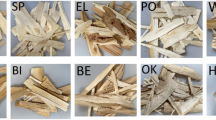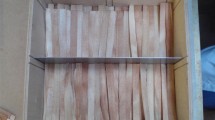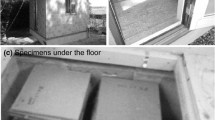Abstract
This research is part of a general study on the properties of oriented strandboard (OSB) using wood strands of species from Brazilian planted forests. The OSB industry is the latest wood related activity established in Brazil. In this particular part of the study, 80 mm long strands of Pinus taeda L. were bonded using two resin types (urea-formaldehyde and phenol-formaldehyde) at two levels of resin content (5% and 8%) to produce three-layer cross-aligned OSB to a face to core layer ratio of 1:2 and target density of 0.75 g/cm3. Physical and mechanical properties of the boards were evaluated according to ASTM standard D 1037-96a (1997) and the results compared to standards available as requirements for commercial structural panels. The results indicate that all the mechanical properties evaluated were above the requirements set forth by the Canadian standard CSA O437.0 (1993) for structural panels. The results of Janka hardness were in average 4 folds higher than the minimal requirements for Grade R-1 waferboard. Screw withdrawal values were also above the minimum required by grade M-3 of ANSI A208.1 standard (1993). Nevertheless, values of thickness swelling and water absorption were very high. The low dimensional stability may be related to the high density of the boards (“springback” effect) and also to the fact that no wax was used.
Zusammenfassung
Diese Arbeit ist Teil einer allgemeinen Studie über die Eigenschaften von OSB, die aus Holzsträngen unter Verwendung von Spezialhölzern aus brasilianischen Wäldern hergestellt wurden. Die OSB-Industrie ist die neueste holzbezogene Einrichtung in Brasilien. In diesem besonderen Teil der Studie, wurden 80 mm lange Späne von Pinus taeda L. mit zwei Klebertypen (Harnstoff- und Phenolformaldehyd) zusammengefügt zu zwei Stufen des Harzgehalts (5% und 8%), um dreilagige überkreuzte OSBs herzustellen und ein Verhältnis von 1:2 und eine Zieldichte von 0,75 g/cm3 zu erhalten. Physikalische und mechanische Eigenschaften der Platten wurden nach dem ASTM Standard D 1037-96a abgeschätzt und die Ergebnisse verglichen mit den Standards, die verfügbar sind als Erfordernis für kommerzielle Bauplatten. Die Ergebnisse der Janka-Härte waren im Durchschnitt 4-mal höher als die Minimalerfordernisse für Grad R-1 waferboards. Schraubenwiderstandswerte lagen ebenfalls über den Minimalerfordernissen des Grad M-3 von ANSI A208.1 Standards. Jedoch waren die Werte der Dickenquellung und der Wasseraufnahme sehr hoch. Die Dimensionsstabilität könnte mit der hohen Dichte der Platten („springback“-Effekt) und auch mit der Tatsache, dass kein Wachs verwendet wurde zusammenhängen.
Similar content being viewed by others
Avoid common mistakes on your manuscript.
1 Introduction
The OSB industry has been experiencing fast expansion to other countries outside North America and Europe. Chile was the first market in South America where an OSB plant was established. All the OSB panels consumed in Brazil so far were imported from Europe and the production in the first plant started up in 2001. The sixty million dollar plant is located in the State of Paraná with a capacity of 360,000 m3/year. The main applications of OSB in Brazil are foreseen as packaging, panels for exposition fairs, and concrete form-work. This kind of reconstituted panel will compete in the aforementioned applications with plywood, which uses mainly urea- and phenol-formaldehyde as bonding resins.
According to the Brazilian Society of Silviculture-SBS (2000) the area of planted wood species in Brazil is 4.8 million ha, of which 38% is occupied by species of Pinus and 62% by Eucalyptus. The possibility of using timber of low commercial value and the local supply of fast growing wood species from planted sustainable forests are the main reasons to establish the industry in Brazil. In addition, Brazil has a large domestic market for wood-based panels and not many information and studies are available on the properties and utilization of wood species from planted Brazilian forests for the OSB production. As the market share of OSB is increased, so will be the need for more research and information concerning available raw material.
The purpose of this study was to manufacture three-layered OSB panels using strands of planted-grown species of Pinus taeda L., to evaluate the physical and mechanical properties of the panels and to compare whether the results meet the requirements of available standards for structural panels.
2 Methods
Planks of 18-year-old Pinus taeda L. were cut into small blocks and strands with density of 0.43 g/cm3 were generated by using a high-speed disk-cut flaker. The strands, averaging 0.7×20×70 mm, were screened and used those passing through 24 mm and retained on an 8-mm opening screen.
The adhesives used in this experiment were commercially available urea-formaldehyde (U-F) and phenol-formaldehyde (P-F), without any addition of wax. The viscosity of the U-F resin was adjusted to 267 mPa.s (267 cP), according to ASTM D 1490-67 (1972) standard, and 66% of solid contents. The P-F resin was adjusted to the viscosity of 467 mPa.s (467 cP), according to the standard ASTM D 4426-84 (1984), and 47% of solid contents. Each type of resin (U-F and P-F) was added to the strands at 5% and 8% resin solids content (based on oven-dry weight of the strands).
The OSB panels were hand-formed into three layers (face to core ratio of 1:2), aligned in the same direction of orientation and the core layer was aligned in an angle of 90 degrees. All mats were pressed onto manually controlled, steam-heated press platens at 175°C for 10 min and 4 MPa of pressure. Three replications (panels) were produced in each experimental condition with a target density of 0.75 g/cm3 and thickness of 13 mm. The panels measuring 450×450 mm were conditioned at 21°C and 65% of relative humidity, to reach the equilibrium moisture content of 12±2%. The panels were tested according to ASTM D 1037-96a (1997) and results compared to standards Canadian Standards Association-CSA (CSA O437.0 [1993]) and American National Standards Institute-ANSI (ANSI A208.1 [1993]), used as requirement for structural panels.
The experimental design was a completely randomized factorial design. The results of the properties tested were submitted to an overall analysis of variance (ANOVA). The homogeneity of the means combinations was tested using the Tukey HSD test.
3 Results and discussion
Results of the physical and mechanical properties of OSB panels are presented in Table 1. All mechanical properties evaluated met the requirements set forth by the standards for commercial panels. OSB bending strength values obtained in both directions of strands alignment were superior to those required by CSA O437.0 standard (1993), classified as class O-2. Regarding modulus of rupture-MOR, the values were 24%–81% higher in the parallel direction as compared to the same standard. Results of MOR were higher in the cross alignment direction (89%–180%). The higher the orientation, the greater will be the increase/decrease of strength properties on the parallel and cross directions, respectively. The ratios of parallel/perpendicular MOR values ranged from 1.5–1.7.
The panels presented modulus of elasticity-MOE in the lengthwise direction equal or as much as 10% higher than the requirements of the Canadian standard. MOE in the perpendicular direction was 53%–100% higher than the requirements.
Using the regression equation cited by Geimer (1986), the percent alignment of the manufactured boards placed between 21.3% and 26.9%. According to the author, a percent alignment around 28% is considered a good result. Regarding the present study, the result of alignment obtained can be considered very efficient, which resulted in good bending properties. The OSB manufactured in the present study also compares with those studied by Wu and Suchsland (1997) made with southern pine strands and used as I-beam web.
Values of stress at proportional limit-SPL ranged from 17.5–26.0 MPa, and showed two identical homogeneous groups as for parallel and perpendicular alignments. The ratio of parallel to perpendicular values of SPL ranged from 2.0–2.3.
Values of internal bond-IB were 1.3–2.8-folds higher than the specification of the Canadian standard. It is an indicator of good adhesion, as well as efficient resin spreading and fine atomization. Values of screw withdrawal-SW perpendicular to the board surface improved as the resin type and amount increased. All values of SW were higher than the grade M-3 of American standard ANSI A208.1 (1993). This property showed three homogeneous groups and the magnitude of these values were quite similar. Both resin type and resin level influenced the SW property. Panels bonded with P-F resin at 8% solids content yielded higher strength to SW. The hardness Janka-HJ values ranged from 8,229 to 10,321 N and were 3.5 to 4.6-folds higher than the minimal requirement for waferboard, class R-1. According to the Tukey HSD test, this property showed only one homogeneous group. It means that neither factor interfered in the property.
The Tukey test showed only one homogeneous group for density. The ratio of strands compaction was about 1.74. The moisture contents of the four treatments were quite similar, reaching 8.8%, and no difference was evident according to the ANOVA.
As stated by Hsu (1987), thickness swelling-TS is the sum of three components, i. e., reversible swelling of the wood itself, “springback” of compressed wood, and separation of furnish. After 2 h of water immersion the thickness swelling ranged from 37%–65% and increased to 44%–77%, after 24 h water immersion. According to CSA O.437.0 (1993), the maximum value for Class O-2 is 15%, for 24 h of water immersion and board thickness up to 1.27 cm. All the TS values were much higher even for the boards with P-F resin. Basis for this can be the higher density of the final boards, which sets up an increasing effect of “springback”. The higher the board density, the higher the compaction ratio. The stress inside the panel is particularly released when submitted to water immersion. It is more pronounced as higher is the “springback” effect. The same is applied to the water absorption-WA property, which presented uptake limits ranging from 56%–92%, after 2 h, and increased to 77%–118%, after 24 h. All these values of WA seem too high and an improvement should be done as the same described to avoid the thickness swelling increasing. WA showed two and three homogeneous groups, after 2 h and 24 h of water immersion, respectively.
4 Conclusions
Mechanical properties of the OSB studied were well above the requirements of the Canadian standard CSA O437.0 (1983). Even OSB bonded with U-F resin met the requirements for all mechanical properties. Only boards with 5% of U-F resin tested presented MOE in the parallel direction the same as the standard requirement. SW and HJ were also up above the requirements set forth by the grade M-3 of ANSI A208.1 (1993). The parallel to perpendicular ratios confirm that strands alignment was very homogeneous and highly efficient, as noted by the low variation in the bending properties.
The values of dimensional stability (TS and WA) were very high; hence an improvement has to be attained to reduce water uptake and thickness swelling. Two actions can be taken to increase dimensional stability: adding wax in the blending machine during the manufacturing process and reducing the panels’ density to decrease “springback” effect.
Regarding mechanical properties, resin level had significant difference on the properties of IB for panels blended with P-F resin as well as on SW for boards bonded with U-F resin. Therefore, for the other properties lower resin content (5%) can be used in manufacturing panels of desirable properties, as compared to the 8% resin content. Effect of resin type was more pronounced over MOR, SPL, and SW, with panels bonded with P-F resin yielding higher values than U-F. Concerning physical properties, results showed no significant difference with regard to resin levels, when P-F resin was used. Generally speaking, resin type and resin level did not have a significant difference over the properties of MOE, HJ, and density.
The results show the feasibility of using wood strands of Pinus taeda L. from Brazilian planted forests for OSB manufacturing, which is important to qualify appropriate raw material supply for the industry.
References
American Society for Testing and Materials (1997) Standard test methods for evaluating properties of wood-base fiber and particle panel materials. ASTM D 1037-96a. Annual Book of ASTM Standards 04.10, ASTM, West Conshohocken, pp 379–382
American Society for Testing and Materials (1972) Standard test methods for nonvolatile content of urea-formaldehyde resin solutions. ASTM D 1490-67. Annual Book of ASTM Standards, vol. 04.09, American Society for Testing and Materials, Philadelphia
American Society for Testing and Materials (1984) Standard test methods for determination of percent nonvolatile content of liquid phenolic resins used for wood laminating. ASTM D 4426-84. Annual Book of ASTM Standards, vol. 15.06, American Society for Testing and Materials, Philadelphia
American National Standards Institute (1993) Particleboard. Specification ANSI A 208.1-1993. National Particleboard Association, Gaithersburg, p 9
Canadian Standards Association (1993) Oriented strandboard and waferboard. Technical Bulletin SBA, Standard CSA O437.0-93. Willowdale, Ontario, Canada
Geimer RL (1986) Mechanical properties ratios—a measure of flake alignment. Res. Pap. 468. U.S. Department of Agriculture, Forest Service, Forest Products Laboratory, Madison, p 10
Hsu WE (1987) A process for stabilizing waferboard/OSB. In: Proceedings of the Washington State University. Particleboard Symposium, no 21, pp 219–236
Sociedade Brasileira de Silvicultura-SBS (2000) Official website of the SBS. http://www.sbs.org.br. Cited December 13, 2003
Wu Q, Suchsland O (1997) Effect of moisture on the flexural properties of commercial oriented strand boards. Wood Fiber Sci 29(1):47–57
Acknowledgements
The authors gratefully thank Mr. Roberto Trevisan from Placas do Paraná S.A. and Mr. Mário de Andrade from Alba Química Ltda., for donating the wood and resins, respectively, used in this study. Thanks are also extended to the technicians João Anacleto, Sérgio Martinez, and Getúlio Almeida.
Author information
Authors and Affiliations
Corresponding author
Rights and permissions
About this article
Cite this article
Okino, E.Y.A., Teixeira, D.E., de Souza, M.R. et al. Properties of oriented strandboard made of wood species from Brazilian planted forests: Part 1: 80 mm-long strands of Pinus taeda L.. Holz Roh Werkst 62, 221–224 (2004). https://doi.org/10.1007/s00107-004-0472-3
Published:
Issue Date:
DOI: https://doi.org/10.1007/s00107-004-0472-3




